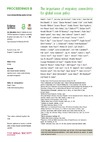Identificador persistente para citar o vincular este elemento:
https://accedacris.ulpgc.es/jspui/handle/10553/58317
| Título: | The importance of migratory connectivity for global ocean policy | Autores/as: | Dunn, Daniel C. Harrison, Autumn-Lynn Curtice, Corrie DeLand, Sarah Donnelly, Ben Fujioka, Ei Heywood, Eleanor Kot, Connie Y. Poulin, Sarah Whitten, Meredith Akesson, Susanne Alberini, Amalia Appeltans, Ward Manuel Arcos, Jos Bailey, Helen Ballance, Lisa T. Block, Barbara Blondin, Hannah Boustany, Andre M. Brenner, Jorge Catry, Paulo Cejudo, Daniel Cleary, Jesse Corkeron, Peter Costa, Daniel P. Coyne, Michael Crespo, Guillermo Ortuno Davies, Tammy E. Dias, Maria P. Douvere, Fanny Ferretti, Francesco Formia, Angela Freestone, David Friedlaender, Ari S. Frisch-Nwakanma, Heidrun Frojan, Christopher Barrio Gjerde, Kristina M. Glowka, Lyle Godley, Brendan J. Gonzalez-Solis, Jacob Granadeiro, Jose Pedro Gunn, Vikki Hashimoto, Yuriko Hawkes, Lucy M. Hays, Graeme C. Hazin, Carolina Jimenez, Jorge Johnson, David E. Luschi, Paolo Maxwell, Sara M. McClellan, Catherine Modest, Michelle di Sciara, Giuseppe Notarbartolo Palacio, Alejandro Herrero Palacios, Daniel M. Pauly, Andrea Rayner, Matt Rees, Alan F. Salazar, Erick Ross Secor, David Sequeira, Ana M. M. Spalding, Mark Spina, Fernando Van Parijs, Sofie Wallace, Bryan Varo_Cruz, Nuria Virtue, Melanie Weimerskirch, Henri Wilson, Laurie Woodward, Bill Halpin, Patrick N. |
Clasificación UNESCO: | 240119 Zoología marina | Palabras clave: | Marine Conservation Tracking Consequences Biodiversity, et al. |
Fecha de publicación: | 2019 | Publicación seriada: | Proceedings of the Royal Society B: Biological Sciences | Resumen: | The distribution of migratory species in the ocean span local, national and international jurisdictions. Across these ecologically interconnected regions, migratory marine species interact with anthropogenic stressors throughout their lives. Migratory connectivity, the geographical linking of individuals and populations throughout their migratory cycles, influences how spatial and temporal dynamics of stressors affect migratory animals and scale up to influence population abundance, distribution and species persistence. Population declines of many migratory marine species have led to calls for connectivity knowledge, especially insights from animal tracking studies, to be more systematically and synthetically incorporated into decision-making. Inclusion of migratory connectivity in the design of conservation and management measures is critical to ensure they arc appropriate for the level of risk associated with various degrees of connectivity. Three mechanisms exist to incorporate migratory connectivity into international marine policy which guides conservation implementation: site-selection criteria, network design criteria and policy recommendations. Here, We review the concept of migratory connectivity and its use in international policy, and describe the Migratory Connectivity in the Ocean system, a migratory connectivity evidence-base for the ocean. We propose that without such collaboration focused on migratory connectivity, efforts to effectively conserve these critical species across jurisdictions will have limited effect. | URI: | https://accedacris.ulpgc.es/handle/10553/58317 | ISSN: | 0962-8452 | DOI: | 10.1098/rspb.2019.1472 | Fuente: | Proceedings Of The Royal Society B-Biological Sciences [ISSN 0962-8452], v. 286 (1911) |
| Colección: | Artículos |
Citas SCOPUSTM
102
actualizado el 08-jun-2025
Citas de WEB OF SCIENCETM
Citations
98
actualizado el 08-jun-2025
Visitas
47
actualizado el 18-feb-2024
Descargas
97
actualizado el 18-feb-2024
Google ScholarTM
Verifica
Altmetric
Comparte
Exporta metadatos
Los elementos en ULPGC accedaCRIS están protegidos por derechos de autor con todos los derechos reservados, a menos que se indique lo contrario.
